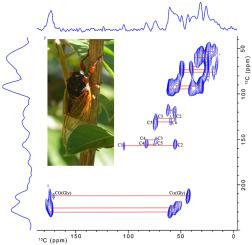Solid State Nuclear Magnetic Resonance ( IF 1.8 ) Pub Date : 2022-11-14 , DOI: 10.1016/j.ssnmr.2022.101838 Frédéric Mentink-Vigier 1 , Samuel Eddy 2 , Terry Gullion 2

|
NMR is a valuable tool for studying insects. Solid-state NMR has been used to obtain the chemical composition and gain insight into the sclerotization process of exoskeletons. There is typically little difficulty in obtaining sufficient sample quantity for exoskeletons. However, obtaining enough sample of other insect components for solid-state NMR experiments can be problematic while isotopically enriching them is near impossible. This is especially the case for insect wing membranes which is of interest to us. Issues with obtaining sufficient sample are the thickness of wing membranes is on the order of microns, each membrane region is surrounded by veins and occupies a small area, and the membranes are separated from the wing by physical dissection. Accordingly, NMR signal enhancement methods are needed. MAS-DNP has a track record of providing significant signal enhancements for a wide variety of materials. Here we demonstrate that MAS-DNP is useful for providing high quality one-dimensional and two-dimensional solid-state NMR spectra on cicada wing membrane at natural isotopic abundance.
中文翻译:

MAS-DNP 能够对昆虫翅膀进行核磁共振研究
核磁共振是研究昆虫的重要工具。固态核磁共振已被用来获取化学成分并深入了解外骨骼的硬化过程。获得足够的外骨骼样本量通常不存在什么困难。然而,获得足够的其他昆虫成分样本用于固态核磁共振实验可能存在问题,而同位素富集它们几乎是不可能的。我们感兴趣的昆虫翼膜尤其如此。获得足够样本的问题是机翼膜的厚度为微米量级,每个膜区域都被静脉包围并占据很小的面积,并且通过物理解剖将膜与机翼分离。因此,需要NMR信号增强方法。 MAS-DNP 拥有为多种材料提供显着信号增强的记录。在这里,我们证明 MAS-DNP 可用于在蝉翼膜上提供天然同位素丰度的高质量一维和二维固态 NMR 谱。

































 京公网安备 11010802027423号
京公网安备 11010802027423号